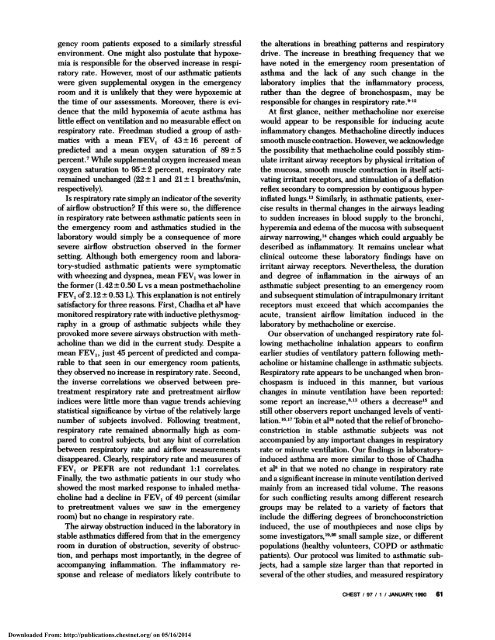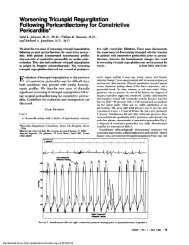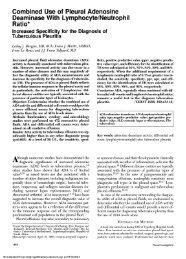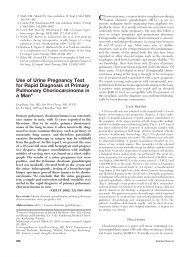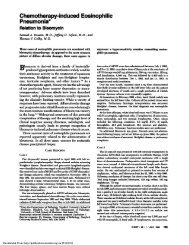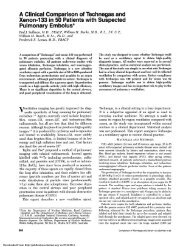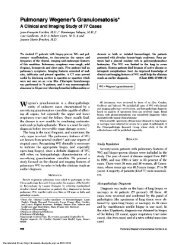Respiratory Rate during Acute Asthma*
Respiratory Rate during Acute Asthma*
Respiratory Rate during Acute Asthma*
You also want an ePaper? Increase the reach of your titles
YUMPU automatically turns print PDFs into web optimized ePapers that Google loves.
gency room patients exposed to a similarly stressfulenvironment. One might also postulate that hypoxemiais responsible for the observed increase in respiratoryrate. However, most of our asthmatic patientswere given supplemental oxygen in the emergencyroom and it is unlikely that they were hypoxemic atthe time of our assessments. Moreover, there is evidencethat the mild hypoxemia of acute asthma haslittle effect on ventilation and no measurable effect onrespiratory rate. Freedman studied a group of asthmaticswith a mean FEY1 of 43 ± 16 percent ofpredicted and a mean oxygen saturation of 89 ± 5percent.7 While supplemental oxygen increased meanoxygen saturation to 95 ± 2 percent, respiratory rateremained unchanged (22 ± 1 and 21 ± 1 breaths!min,respectively).Is respiratory rate simply an indicator ofthe severityof airflow obstruction? If this were so, the differencein respiratory rate between asthmatic patients seen inthe emergency room and asthmatics studied in thelaboratory would simply be a consequence of moresevere airflow obstruction observed in the formersetting. Although both emergency room and laboratory-studiedasthmatic patients were symptomaticwith wheezing and dyspnea, mean FEY1 was lower inthe former (1.42±0.50 L vs a mean postmethacholineFEY1 of2. 12 ± 0.53 L). This explanation is not entirelysatisfactory for three reasons. First, Chadha et al8 havemonitored respiratory rate with inductive plethysmographyin a group of asthmatic subjects while theyprovoked more severe airways obstruction with methacholinethan we did in the current study. Despite amean FEY1, just 45 percent of predicted and comparableto that seen in our emergency room patients,they observed no increase in respiratory rate. Second,the inverse correlations we observed between pretreatmentrespiratory rate and pretreatment airflowindices were little more than vague trends achievingstatistical significance by virtue of the relatively largenumber of subjects involved. Following treatment,respiratory rate remained abnormally high as comparedto control subjects, but any hint of correlationbetween respiratory rate and airflow measurementsdisappeared. Clearly, respiratory rate and measures ofFEY1 or PEFR are not redundant 1:1 correlates.Finally, the two asthmatic patients in our study whoshowed the most marked response to inhaled methacholinehad a decline in FEY1 of 49 percent (similarto pretreatment values we saw in the emergencyroom) but no change in respiratory rate.The airway obstruction induced in the laboratory instable asthmatics differed from that in the emergencyroom in duration of obstruction, severity of obstruction,and perhaps most importantly, in the degree ofaccompanying inflammation. The inflammatory responseand release of mediators likely contribute tothe alterations in breathing patterns and respiratorydrive. The increase in breathing frequency that wehave noted in the emergency room presentation ofasthma and the lack of any such change in thelaboratory implies that the inflammatory process,rather than the degree of bronchospasm, may beresponsible for changes in respiratory rate.’2At first glance, neither methacholine nor exercisewould appear to be responsible for inducing acuteinflammatory changes. Methacholine directly inducessmooth muscle contraction. However, we acknowledgethe possibility that methacholine could possibly stimulateirritant airway receptors by physical irritation ofthe mucosa, smooth muscle contraction in itself activatingirritant receptors, and stimulation ofa deflationreflex secondary to compression by contiguous hyperinflated Similarly, in asthmatic patients, exerciseresults in thermal changes in the airways leadingto sudden increases in blood supply to the bronchi,hyperemia and edema ofthe mucosa with subsequentairway narrowing,’4 changes which could arguably bedescribed as inflammatory. It remains unclear whatclinical outcome these laboratory findings have onirritant airway receptors. Nevertheless, the durationand degree of inflammation in the airways of anasthmatic subject presenting to an emergency roomand subsequent stimulation ofintrapulmonary irritantreceptors must exceed that which accompanies theacute, transient airflow limitation induced in thelaboratory by methacholine or exercise.Our observation of unchanged respiratory rate followingmethacholine inhalation appears to confirmearlier studies of ventilatory pattern following methacholineor histamine challenge in asthmatic subjects.<strong>Respiratory</strong> rate appears to be unchanged when bronchospasmis induced in this manner, but variouschanges in minute ventilation have been reported:some report an increase,8”3 others a decrease’5 andstill other observers report unchanged levels of ventilation.16,17Tobin et alh8 noted that the relief of bronchoconstrictionin stable asthmatic subjects was notaccompanied by any important changes in respiratoryrate or minute ventilation. Our findings in laboratoryinducedasthma are more similar to those of Chadhaet al8 in that we noted no change in respiratory rateand a significant increase in minute ventilation derivedmainly from an increased tidal volume. The reasonsfor such conflicting results among different researchgroups may be related to a variety of factors thatinclude the differing degrees of bronchoconstrictioninduced, the use of mouthpieces and nose clips bysome investigators,’9’2#{176} small sample size, or differentpopulations (healthy volunteers, COPD or asthmaticpatients). Our protocol was limited to asthmatic subjects,had a sample size larger than that reported inseveral of the other studies, and measured respiratoryCHEST I 97 I I I JANUARY, 1990 61Downloaded From: http://publications.chestnet.org/ on 05/16/2014


